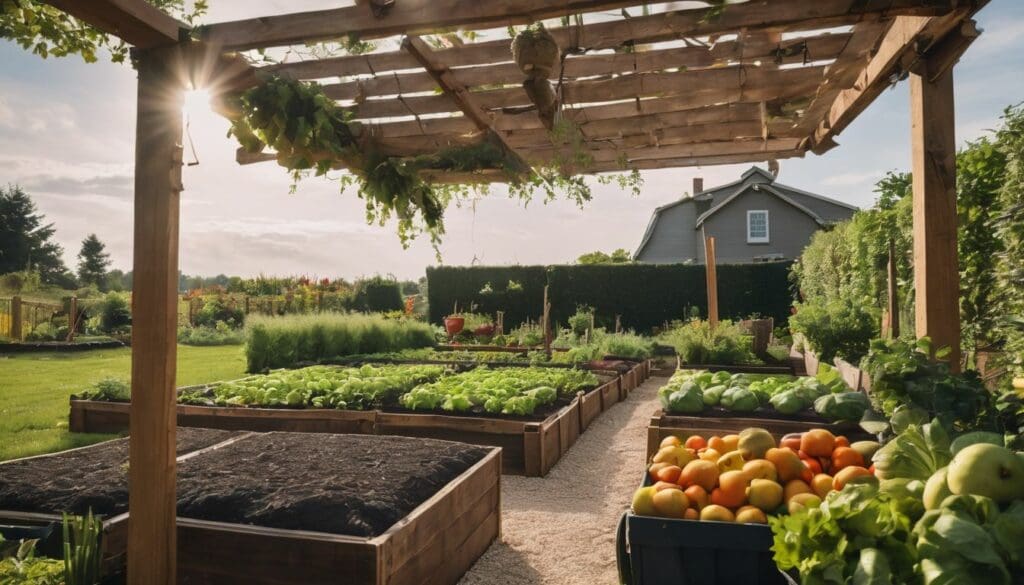As dedicated gardeners, we’re all too aware of the potential impact that our passion for verdant spaces may have on the delicate balance of nature. It’s a concern that’s close to our hearts, and in response, we’ve thoroughly researched how to harmonise our hobby with environmental stewardship.
The revelation has been quite inspiring: by embracing organic gardening practices, we can reduce carbon emissions by as much as 40%. Our expertise is at your disposal; let us guide you towards eco-friendly choices that will benefit both your treasured garden and our planet.
Together, let’s nurture a positive change—shall we begin the journey?.
Key Takeaways
- Eco – friendly gardening reduces our carbon footprint by avoiding synthetic fertilisers and pesticides, which are known to contaminate water and disrupt ecosystems. Instead, it prioritises the use of natural fertilisers like homemade compost.
- Encouraging wildlife through planting native species and companion planting not only enhances garden biodiversity but also naturally manages pests without harmful chemicals.
- Sustainable gardening involves choosing tools made from recycled or sustainable materials, as well as implementing rainwater harvesting systems to conserve water resources.
- Growing your own food using organic seeds and employing crop rotation can significantly cut down on the environmental impact associated with commercially grown produce.
- Drought-resistant plants are key in creating a low-maintenance, water-conserving garden that supports local ecosystems while adding beauty to the landscape.
Understanding Eco-Friendly Gardening
By understanding the principles of eco-friendly gardening, we can actively reduce our carbon footprint and minimise the negative impact on the environment. This involves avoiding synthetic fertilisers and pesticides, encouraging wildlife in our gardens, and implementing sustainable gardening practices.
Definition and philosophy
Eco-friendly gardening embraces a philosophy that works in harmony with nature, aiming to minimise harm and promote environmental health. We prioritise sustainable landscaping options, choosing materials and practices that support ecosystems instead of disrupting them.
It’s not just about reducing our carbon footprint; it involves making conscious decisions at every step – from the design of your garden to the products you select.
We understand that every choice can have a profound impact on the environment, which is why we opt for natural gardening supplies and organic gardening methods. Our approach combines respect for biological diversity with a steadfast commitment to conservation and environmental stewardship.
Through environmentally friendly yard care, we work towards creating spaces that are both beautiful and beneficial for all forms of life.
Benefits of eco-friendly gardening
Eco-friendly gardening benefits the environment by reducing chemical use and promoting biodiversity. By using natural fertilisers, avoiding synthetic pesticides, and embracing companion planting, sustainable gardeners create healthy ecosystems that thrive without harming the earth.
Additionally, eco-friendly gardening conserves water and reduces waste through practices such as rainwater harvesting and composting. These green techniques not only benefit the environment but also contribute to a healthier lifestyle by providing fresh organic produce free from harmful chemicals.
Moreover, environmentally conscious gardening contributes to carbon footprint reduction by sequestering carbon in soils and plants while supporting local wildlife habitats. Sustainable gardens are not only beautiful but also provide a safe haven for pollinators like bees and butterflies.
With mindful planning, individuals can transform their outdoor spaces into vibrant landscapes that nurture both people and nature.
Reducing carbon footprint
To reduce our carbon footprint in gardening, we can choose sustainable materials and practices. Using organic fertilisers, composting kitchen waste, and avoiding synthetic pesticides all contribute to a greener garden.
Additionally, planting trees and using drought-resistant plants help sequester carbon from the atmosphere while reducing water usage. By making simple changes in the way we maintain our gardens, we can actively participate in environmental conservation efforts.
Encouraging wildlife by creating habitats and companion planting also helps to balance ecosystems. These natural methods contribute to reducing the impact of traditional gardening practices on the environment.
Non-eco-friendly aspects of normal gardening
Traditional gardening often relies heavily on synthetic fertilisers and pesticides, which can harm the environment by contaminating water sources and disrupting local ecosystems. The use of petrol-powered tools also contributes to pollution and greenhouse gas emissions.
Additionally, non-eco-friendly gardening practices often involve excessive water usage, leading to strain on local water supplies.
To address these negative impacts, it’s essential to consider alternative methods that minimise harm to the environment while still maintaining a healthy garden. By shifting away from conventional chemical treatments and embracing sustainable practices, we can reduce our carbon footprint and create a more eco-friendly outdoor space for both ourselves and the surrounding wildlife.
Choosing Sustainable Products for Your Garden
Making your own fertilisers and compost, avoiding synthetic fertilisers and pesticides, and encouraging wildlife and companion planting are all sustainable ways to care for your garden.
To find out more about environmentally safe gardening products, continue reading our blog.
Making your own fertilisers and compost
To create environmentally safe gardening products, consider making your own fertilisers and compost using natural ingredients. This allows you to control what goes into the soil and reduces the use of synthetic chemicals, helping to support a healthier ecosystem. Additionally, it is a cost-effective way to recycle organic waste and enrich the soil with essential nutrients. Here are some methods for making eco-friendly fertilisers and compost:
- Utilise kitchen scraps such as fruit peels, coffee grounds, and eggshells to create nutrient – rich compost.
- Make natural fertilisers by fermenting weeds or creating compost tea from organic materials like seaweed or nettles.
- Introduce beneficial microorganisms by adding biological activators like manure or bokashi to the compost pile.
- Incorporate mulch as an effective way to retain moisture, suppress weeds, and improve soil structure without harmful chemicals.
- Compost yard waste including grass clippings, leaves, and twigs along with vegetable scraps for a more sustainable garden.
Avoiding synthetic fertilisers and pesticides
When choosing environmentally safe gardening products, it’s important to steer clear of synthetic fertilisers and pesticides. These products can have harmful effects on the environment and wildlife. Instead, opt for natural alternatives such as:
- Using organic compost and natural fertilisers made from kitchen waste and garden clippings.
- Implementing companion planting to naturally repel pests and promote plant growth without chemical interference.
- Attracting beneficial insects like ladybirds and lacewings to control pest populations without resorting to chemical pesticides.
- Mulching with organic materials like straw or leaves to suppress weeds and retain moisture in the soil without the need for synthetic herbicides.
- Employing physical barriers such as row covers or netting to protect plants from pests rather than relying on chemical sprays.
Encouraging wildlife and companion planting
Encouraging wildlife in your garden can be achieved by planting native flowers and shrubs. These plants attract birds, bees, and butterflies, creating a thriving ecosystem in your yard.
Additionally, companion planting helps to naturally repel pests and promote the overall health of your garden. By strategically interplanting compatible species, you can enhance biodiversity while reducing the need for chemical pesticides.
Moreover, incorporating features such as bird baths or insect hotels provides essential resources for local wildlife. Creating a welcoming habitat not only benefits the environment but also adds beauty and interest to your garden space.
Growing Your Own Food
Growing your own food has numerous benefits, from reducing your carbon footprint to promoting sustainable living. Discover the best techniques for growing food sustainably and using drought-resistant plants to create a more environmentally friendly garden.
Benefits of growing your own food
Growing your own food has numerous benefits for both you and the environment. By cultivating your fruits and vegetables, you can reduce the carbon footprint associated with transportation and storage.
Additionally, home-grown produce tends to be fresher and more nutritious than store-bought options. You also have complete control over the use of pesticides, allowing you to opt for environmentally friendly or organic alternatives.
Cultivating a personal vegetable patch encourages sustainable gardening practices such as composting, water conservation, and biodiversity promotion.
Moreover, growing your own food fosters a deeper connection with nature and promotes self-sufficiency. It’s satisfying to harvest what you’ve nurtured from seedlings to fully grown plants on your dinner table.
Sustainable techniques for growing food
To grow food sustainably, use organic seeds and avoid genetically modified organisms. Rotate crops to prevent soil depletion and minimise the need for fertilisers. Utilise natural pest control methods like companion planting and attract beneficial insects to your garden. Employ water-saving techniques such as mulching and drip irrigation systems to conserve water. Embrace permaculture principles by creating a diverse and self-sustaining ecosystem in your garden. Choose heritage or heirloom varieties of plants to preserve biodiversity and traditional agricultural practices. Implement vertical gardening techniques to maximise space and increase yield without expanding your garden footprint.
Using drought-resistant plants
Choosing to incorporate drought-resistant plants in your garden is a sustainable way to conserve water and maintain an environmentally friendly outdoor space. These plants have adapted to thrive in arid conditions, requiring minimal watering once established.
By using drought-resistant plants, you can significantly reduce your garden’s water consumption and contribute to conserving this valuable resource for future generations.
Not only do drought-resistant plants offer environmental benefits, but they also add natural beauty and texture to your garden landscape. Their ability to withstand dry conditions makes them ideal for low-maintenance gardening, saving time and effort while still creating a visually appealing outdoor space that supports the local ecosystem.
Best Eco-Friendly Gardening Tools
When it comes to choosing the best eco-friendly gardening tools, we’ll explore sustainable alternatives to traditional tools and how to choose products made from recycled or sustainable materials.
Let’s take a closer look at the options available for maintaining an environmentally friendly garden.
Sustainable alternatives to traditional tools
When selecting gardening tools, consider sustainable alternatives that are gentle on the environment. These options are both effective and eco-friendly. Here are some examples of sustainable alternatives to traditional gardening tools:
- Hand Tools: Look for hand tools made from recycled or sustainably sourced materials such as bamboo, stainless steel, or reclaimed wood. These materials reduce the environmental impact of tool production.
- Electric Tools: Opt for electric tools with rechargeable batteries rather than those powered by petrol or petrol. This reduces air and noise pollution in the garden while preserving natural resources.
- Watering System: Install a drip irrigation system to conserve water and ensure efficient watering. This minimises water waste and supports sustainable gardening practices.
- Composting Bins: Use composting bins made from recycled plastic or sustainable materials to create nutrient-rich soil amendments from organic waste, reducing landfill contributions.
- Reusable Containers: Utilise reusable containers for collecting garden waste, such as biodegradable bags or bins made from recycled materials, to minimise single-use plastics in your gardening activities.
- Protective Gear: Invest in protective gear made from sustainable materials such as organic cotton or hemp to limit exposure to harmful synthetic fibres and chemicals commonly found in conventional gear.
Choosing products made from recycled or sustainable materials
When looking for environmentally safe gardening products, opt for those made from recycled or sustainable materials. Here are some options to consider:
- Recycled plastic plant pots and containers are a great eco – friendly choice, as they reduce the demand for new plastic production.
- Look for gardening gloves made from sustainable materials such as bamboo, natural rubber, or organic cotton to minimise environmental impact.
- Consider using rainwater harvesting systems to collect and reuse water in your garden, reducing the need for additional resources.
- Choose garden tools made from durable materials like stainless steel or FSC-certified wood to ensure longevity and sustainability.
- Opt for natural mulch options such as composted garden waste or wood chips instead of synthetic alternatives to support a more eco-friendly garden environment.
Conclusion
In conclusion, choosing environmentally safe gardening products is crucial for reducing our carbon footprint and supporting sustainable practices. Making your own fertilisers and compost, avoiding synthetic chemicals, and opting for sustainable materials are all steps towards eco-friendly gardening.
By embracing these techniques, we can create a beautiful garden that not only benefits the environment but also provides a healthy space for ourselves and wildlife. Ultimately, by making conscious choices in our gardening practices, we contribute to a more sustainable and healthier planet for future generations.
FAQs
1. What does it mean to choose environmentally safe gardening products?
Choosing environmentally safe gardening products means selecting tools and materials that reduce your carbon footprint, are non-toxic, and support eco-friendly landscaping practices.
2. How can I ensure my garden design is sustainable?
You can create a sustainable garden design by using recycled materials, opting for green gardening techniques, and picking plants that have a positive impact on the environment.
3. Can I find eco-friendly alternatives for all my gardening needs?
Yes! There are natural gardening alternatives available for every aspect of garden care—from organic gardening products to chemical-free options that ensure you’re practising carbon-neutral gardening.
4. Where can I buy sustainable gardening supplies?
Look for stores or online shops specialising in eco-friendly outdoor living spaces; they typically sell a variety of sustainable gardening products including tools, containers, and non-toxic solutions.
5. Why should I use green gardening tools instead of regular ones?
Green gardening tools are designed to be durable and made from earth-friendly materials which not only last longer but also help maintain an ecologically sound garden.





